Comprehensive Analysis of Determinants of Dividend Policies
VerifiedAdded on 2020/07/22
|15
|5697
|123
Report
AI Summary
This report delves into the critical determinants of dividend policies, examining the factors that influence a company's decision to distribute profits to shareholders. It begins with a literature review, introducing the concept of dividend policy and its significance in corporate finance. The report then explores various dividend policy theories, including the dividend irrelevance theory, bird-in-hand theory, signaling hypothesis, tax-effect hypothesis, and the agency costs and free cash flow hypothesis, providing a comprehensive overview of the theoretical underpinnings of dividend decisions. Furthermore, the report identifies and analyzes key determinants of dividend policy, such as agency costs, company size, and profitability, highlighting their impact on dividend payouts. By examining these factors, the report offers valuable insights into how companies make dividend decisions and the implications of these decisions for shareholders and the overall financial health of the organization. The report includes an introduction to the topic, a literature review of the theories, and a discussion on the factors influencing dividend decisions. The report concludes with a detailed conclusion and references.

Determinants of Dividend
Policy
Policy
Paraphrase This Document
Need a fresh take? Get an instant paraphrase of this document with our AI Paraphraser

Table of Contents
Topic: “Analysis about determinants of dividend policies ”...........................................................1
CHAPTER 1: LITERATURE REVIEW.........................................................................................1
1.1: Introduction on Dividend policy:....................................................................................1
1.2: Dividend policy theories.................................................................................................2
1.2:1: Dividend irrelevance theory.........................................................................................2
1.2.2: Bird in hand theory.......................................................................................................3
1.2.3: Signalling Hypothesis...................................................................................................4
1.2.4: Tax-Effect Hypothesis..................................................................................................4
1.2.5: Agency costs and free cash flow hypothesis................................................................5
2: Determinants of dividend policy........................................................................................5
2.1: Factors influencing dividend decision ............................................................................8
2.1.1: Agency cost: ................................................................................................................8
2.1.2: Size...............................................................................................................................9
2.1.3: Profitability...................................................................................................................9
1.2.4: Relationship among dividend and investment decision: ...........................................10
CONCLUSION..............................................................................................................................10
REFERENCES..............................................................................................................................12
Topic: “Analysis about determinants of dividend policies ”...........................................................1
CHAPTER 1: LITERATURE REVIEW.........................................................................................1
1.1: Introduction on Dividend policy:....................................................................................1
1.2: Dividend policy theories.................................................................................................2
1.2:1: Dividend irrelevance theory.........................................................................................2
1.2.2: Bird in hand theory.......................................................................................................3
1.2.3: Signalling Hypothesis...................................................................................................4
1.2.4: Tax-Effect Hypothesis..................................................................................................4
1.2.5: Agency costs and free cash flow hypothesis................................................................5
2: Determinants of dividend policy........................................................................................5
2.1: Factors influencing dividend decision ............................................................................8
2.1.1: Agency cost: ................................................................................................................8
2.1.2: Size...............................................................................................................................9
2.1.3: Profitability...................................................................................................................9
1.2.4: Relationship among dividend and investment decision: ...........................................10
CONCLUSION..............................................................................................................................10
REFERENCES..............................................................................................................................12
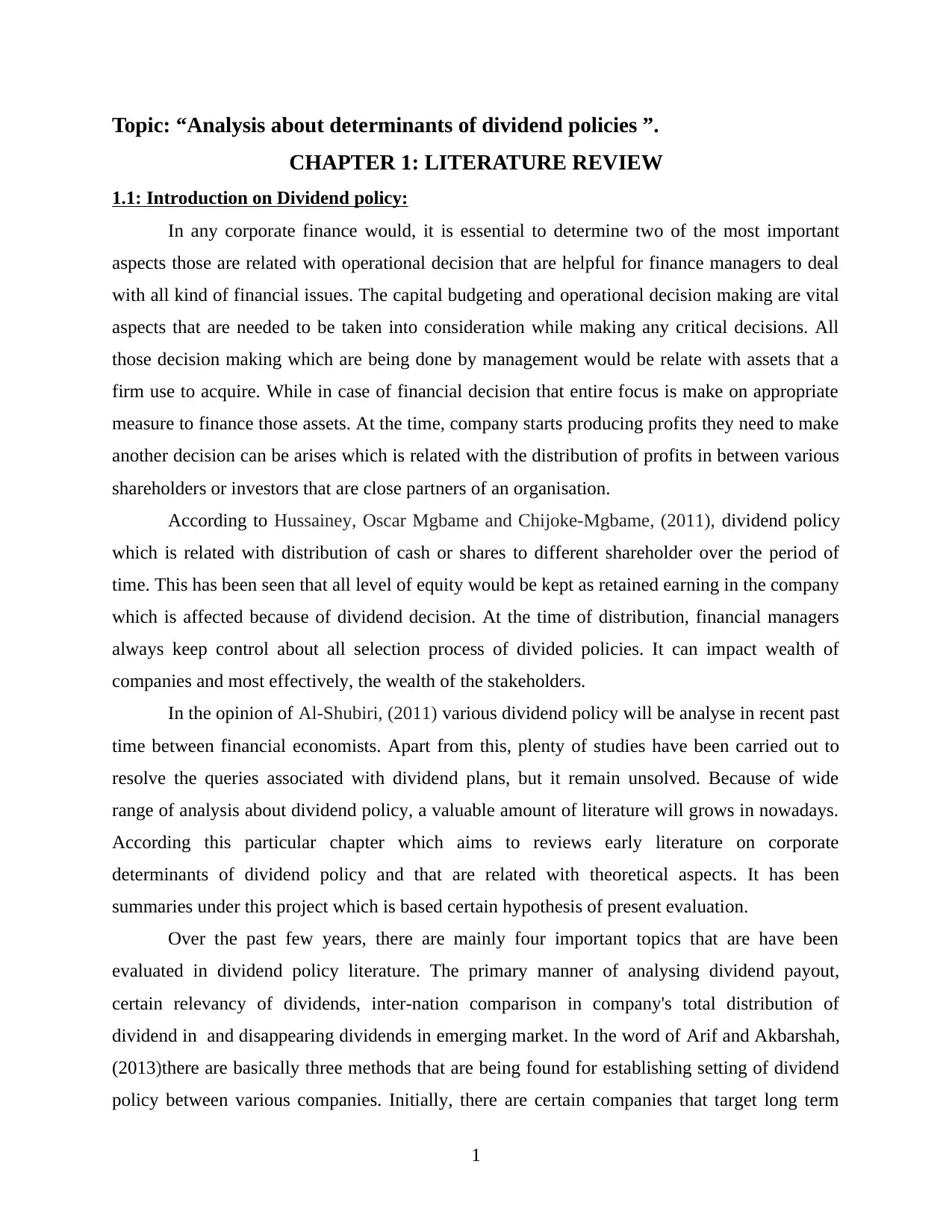
Topic: “Analysis about determinants of dividend policies ”.
CHAPTER 1: LITERATURE REVIEW
1.1: Introduction on Dividend policy:
In any corporate finance would, it is essential to determine two of the most important
aspects those are related with operational decision that are helpful for finance managers to deal
with all kind of financial issues. The capital budgeting and operational decision making are vital
aspects that are needed to be taken into consideration while making any critical decisions. All
those decision making which are being done by management would be relate with assets that a
firm use to acquire. While in case of financial decision that entire focus is make on appropriate
measure to finance those assets. At the time, company starts producing profits they need to make
another decision can be arises which is related with the distribution of profits in between various
shareholders or investors that are close partners of an organisation.
According to Hussainey, Oscar Mgbame and Chijoke-Mgbame, (2011), dividend policy
which is related with distribution of cash or shares to different shareholder over the period of
time. This has been seen that all level of equity would be kept as retained earning in the company
which is affected because of dividend decision. At the time of distribution, financial managers
always keep control about all selection process of divided policies. It can impact wealth of
companies and most effectively, the wealth of the stakeholders.
In the opinion of Al-Shubiri, (2011) various dividend policy will be analyse in recent past
time between financial economists. Apart from this, plenty of studies have been carried out to
resolve the queries associated with dividend plans, but it remain unsolved. Because of wide
range of analysis about dividend policy, a valuable amount of literature will grows in nowadays.
According this particular chapter which aims to reviews early literature on corporate
determinants of dividend policy and that are related with theoretical aspects. It has been
summaries under this project which is based certain hypothesis of present evaluation.
Over the past few years, there are mainly four important topics that are have been
evaluated in dividend policy literature. The primary manner of analysing dividend payout,
certain relevancy of dividends, inter-nation comparison in company's total distribution of
dividend in and disappearing dividends in emerging market. In the word of Arif and Akbarshah,
(2013)there are basically three methods that are being found for establishing setting of dividend
policy between various companies. Initially, there are certain companies that target long term
1
CHAPTER 1: LITERATURE REVIEW
1.1: Introduction on Dividend policy:
In any corporate finance would, it is essential to determine two of the most important
aspects those are related with operational decision that are helpful for finance managers to deal
with all kind of financial issues. The capital budgeting and operational decision making are vital
aspects that are needed to be taken into consideration while making any critical decisions. All
those decision making which are being done by management would be relate with assets that a
firm use to acquire. While in case of financial decision that entire focus is make on appropriate
measure to finance those assets. At the time, company starts producing profits they need to make
another decision can be arises which is related with the distribution of profits in between various
shareholders or investors that are close partners of an organisation.
According to Hussainey, Oscar Mgbame and Chijoke-Mgbame, (2011), dividend policy
which is related with distribution of cash or shares to different shareholder over the period of
time. This has been seen that all level of equity would be kept as retained earning in the company
which is affected because of dividend decision. At the time of distribution, financial managers
always keep control about all selection process of divided policies. It can impact wealth of
companies and most effectively, the wealth of the stakeholders.
In the opinion of Al-Shubiri, (2011) various dividend policy will be analyse in recent past
time between financial economists. Apart from this, plenty of studies have been carried out to
resolve the queries associated with dividend plans, but it remain unsolved. Because of wide
range of analysis about dividend policy, a valuable amount of literature will grows in nowadays.
According this particular chapter which aims to reviews early literature on corporate
determinants of dividend policy and that are related with theoretical aspects. It has been
summaries under this project which is based certain hypothesis of present evaluation.
Over the past few years, there are mainly four important topics that are have been
evaluated in dividend policy literature. The primary manner of analysing dividend payout,
certain relevancy of dividends, inter-nation comparison in company's total distribution of
dividend in and disappearing dividends in emerging market. In the word of Arif and Akbarshah,
(2013)there are basically three methods that are being found for establishing setting of dividend
policy between various companies. Initially, there are certain companies that target long term
1
⊘ This is a preview!⊘
Do you want full access?
Subscribe today to unlock all pages.

Trusted by 1+ million students worldwide
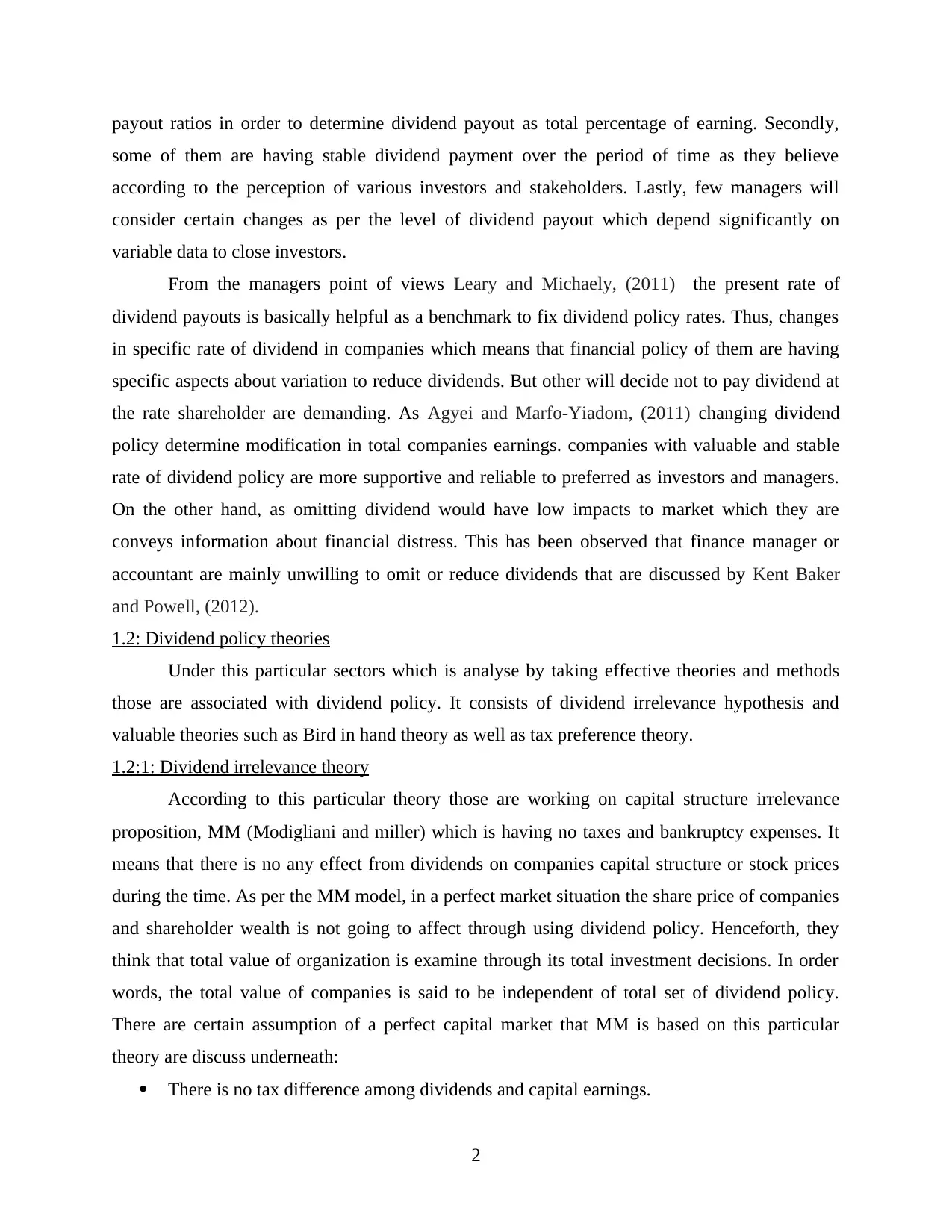
payout ratios in order to determine dividend payout as total percentage of earning. Secondly,
some of them are having stable dividend payment over the period of time as they believe
according to the perception of various investors and stakeholders. Lastly, few managers will
consider certain changes as per the level of dividend payout which depend significantly on
variable data to close investors.
From the managers point of views Leary and Michaely, (2011) the present rate of
dividend payouts is basically helpful as a benchmark to fix dividend policy rates. Thus, changes
in specific rate of dividend in companies which means that financial policy of them are having
specific aspects about variation to reduce dividends. But other will decide not to pay dividend at
the rate shareholder are demanding. As Agyei and Marfo-Yiadom, (2011) changing dividend
policy determine modification in total companies earnings. companies with valuable and stable
rate of dividend policy are more supportive and reliable to preferred as investors and managers.
On the other hand, as omitting dividend would have low impacts to market which they are
conveys information about financial distress. This has been observed that finance manager or
accountant are mainly unwilling to omit or reduce dividends that are discussed by Kent Baker
and Powell, (2012).
1.2: Dividend policy theories
Under this particular sectors which is analyse by taking effective theories and methods
those are associated with dividend policy. It consists of dividend irrelevance hypothesis and
valuable theories such as Bird in hand theory as well as tax preference theory.
1.2:1: Dividend irrelevance theory
According to this particular theory those are working on capital structure irrelevance
proposition, MM (Modigliani and miller) which is having no taxes and bankruptcy expenses. It
means that there is no any effect from dividends on companies capital structure or stock prices
during the time. As per the MM model, in a perfect market situation the share price of companies
and shareholder wealth is not going to affect through using dividend policy. Henceforth, they
think that total value of organization is examine through its total investment decisions. In order
words, the total value of companies is said to be independent of total set of dividend policy.
There are certain assumption of a perfect capital market that MM is based on this particular
theory are discuss underneath:
There is no tax difference among dividends and capital earnings.
2
some of them are having stable dividend payment over the period of time as they believe
according to the perception of various investors and stakeholders. Lastly, few managers will
consider certain changes as per the level of dividend payout which depend significantly on
variable data to close investors.
From the managers point of views Leary and Michaely, (2011) the present rate of
dividend payouts is basically helpful as a benchmark to fix dividend policy rates. Thus, changes
in specific rate of dividend in companies which means that financial policy of them are having
specific aspects about variation to reduce dividends. But other will decide not to pay dividend at
the rate shareholder are demanding. As Agyei and Marfo-Yiadom, (2011) changing dividend
policy determine modification in total companies earnings. companies with valuable and stable
rate of dividend policy are more supportive and reliable to preferred as investors and managers.
On the other hand, as omitting dividend would have low impacts to market which they are
conveys information about financial distress. This has been observed that finance manager or
accountant are mainly unwilling to omit or reduce dividends that are discussed by Kent Baker
and Powell, (2012).
1.2: Dividend policy theories
Under this particular sectors which is analyse by taking effective theories and methods
those are associated with dividend policy. It consists of dividend irrelevance hypothesis and
valuable theories such as Bird in hand theory as well as tax preference theory.
1.2:1: Dividend irrelevance theory
According to this particular theory those are working on capital structure irrelevance
proposition, MM (Modigliani and miller) which is having no taxes and bankruptcy expenses. It
means that there is no any effect from dividends on companies capital structure or stock prices
during the time. As per the MM model, in a perfect market situation the share price of companies
and shareholder wealth is not going to affect through using dividend policy. Henceforth, they
think that total value of organization is examine through its total investment decisions. In order
words, the total value of companies is said to be independent of total set of dividend policy.
There are certain assumption of a perfect capital market that MM is based on this particular
theory are discuss underneath:
There is no tax difference among dividends and capital earnings.
2
Paraphrase This Document
Need a fresh take? Get an instant paraphrase of this document with our AI Paraphraser
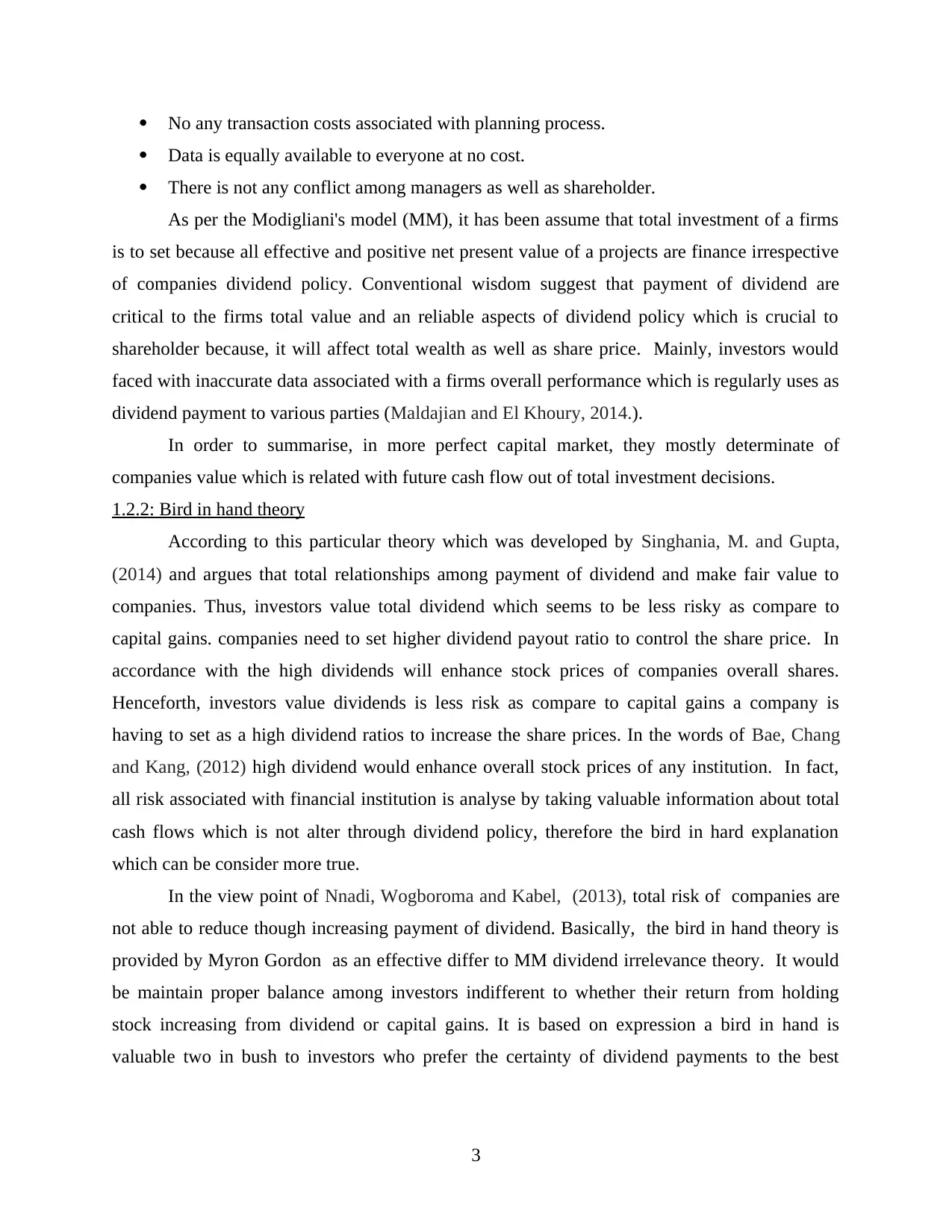
No any transaction costs associated with planning process.
Data is equally available to everyone at no cost.
There is not any conflict among managers as well as shareholder.
As per the Modigliani's model (MM), it has been assume that total investment of a firms
is to set because all effective and positive net present value of a projects are finance irrespective
of companies dividend policy. Conventional wisdom suggest that payment of dividend are
critical to the firms total value and an reliable aspects of dividend policy which is crucial to
shareholder because, it will affect total wealth as well as share price. Mainly, investors would
faced with inaccurate data associated with a firms overall performance which is regularly uses as
dividend payment to various parties (Maldajian and El Khoury, 2014.).
In order to summarise, in more perfect capital market, they mostly determinate of
companies value which is related with future cash flow out of total investment decisions.
1.2.2: Bird in hand theory
According to this particular theory which was developed by Singhania, M. and Gupta,
(2014) and argues that total relationships among payment of dividend and make fair value to
companies. Thus, investors value total dividend which seems to be less risky as compare to
capital gains. companies need to set higher dividend payout ratio to control the share price. In
accordance with the high dividends will enhance stock prices of companies overall shares.
Henceforth, investors value dividends is less risk as compare to capital gains a company is
having to set as a high dividend ratios to increase the share prices. In the words of Bae, Chang
and Kang, (2012) high dividend would enhance overall stock prices of any institution. In fact,
all risk associated with financial institution is analyse by taking valuable information about total
cash flows which is not alter through dividend policy, therefore the bird in hard explanation
which can be consider more true.
In the view point of Nnadi, Wogboroma and Kabel, (2013), total risk of companies are
not able to reduce though increasing payment of dividend. Basically, the bird in hand theory is
provided by Myron Gordon as an effective differ to MM dividend irrelevance theory. It would
be maintain proper balance among investors indifferent to whether their return from holding
stock increasing from dividend or capital gains. It is based on expression a bird in hand is
valuable two in bush to investors who prefer the certainty of dividend payments to the best
3
Data is equally available to everyone at no cost.
There is not any conflict among managers as well as shareholder.
As per the Modigliani's model (MM), it has been assume that total investment of a firms
is to set because all effective and positive net present value of a projects are finance irrespective
of companies dividend policy. Conventional wisdom suggest that payment of dividend are
critical to the firms total value and an reliable aspects of dividend policy which is crucial to
shareholder because, it will affect total wealth as well as share price. Mainly, investors would
faced with inaccurate data associated with a firms overall performance which is regularly uses as
dividend payment to various parties (Maldajian and El Khoury, 2014.).
In order to summarise, in more perfect capital market, they mostly determinate of
companies value which is related with future cash flow out of total investment decisions.
1.2.2: Bird in hand theory
According to this particular theory which was developed by Singhania, M. and Gupta,
(2014) and argues that total relationships among payment of dividend and make fair value to
companies. Thus, investors value total dividend which seems to be less risky as compare to
capital gains. companies need to set higher dividend payout ratio to control the share price. In
accordance with the high dividends will enhance stock prices of companies overall shares.
Henceforth, investors value dividends is less risk as compare to capital gains a company is
having to set as a high dividend ratios to increase the share prices. In the words of Bae, Chang
and Kang, (2012) high dividend would enhance overall stock prices of any institution. In fact,
all risk associated with financial institution is analyse by taking valuable information about total
cash flows which is not alter through dividend policy, therefore the bird in hard explanation
which can be consider more true.
In the view point of Nnadi, Wogboroma and Kabel, (2013), total risk of companies are
not able to reduce though increasing payment of dividend. Basically, the bird in hand theory is
provided by Myron Gordon as an effective differ to MM dividend irrelevance theory. It would
be maintain proper balance among investors indifferent to whether their return from holding
stock increasing from dividend or capital gains. It is based on expression a bird in hand is
valuable two in bush to investors who prefer the certainty of dividend payments to the best
3
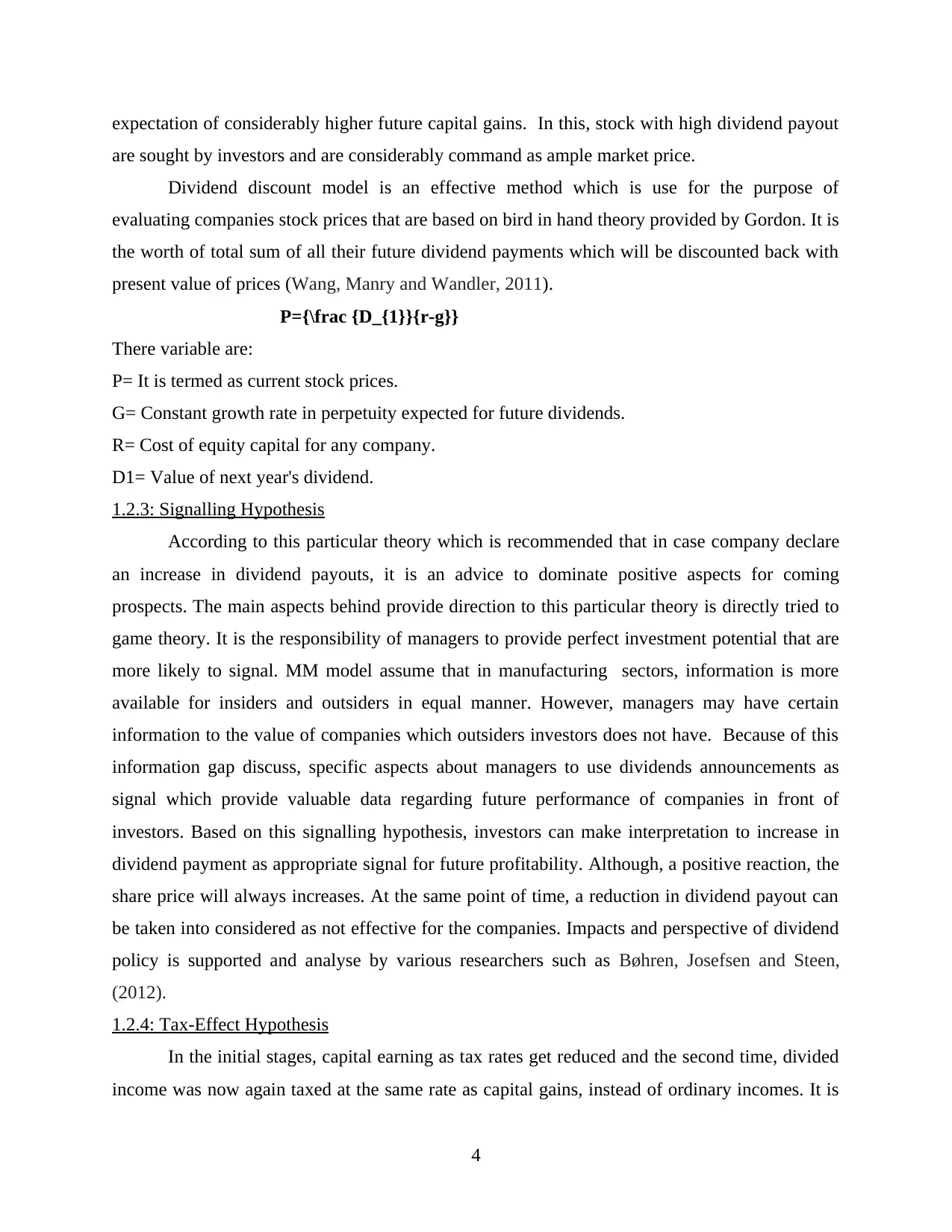
expectation of considerably higher future capital gains. In this, stock with high dividend payout
are sought by investors and are considerably command as ample market price.
Dividend discount model is an effective method which is use for the purpose of
evaluating companies stock prices that are based on bird in hand theory provided by Gordon. It is
the worth of total sum of all their future dividend payments which will be discounted back with
present value of prices (Wang, Manry and Wandler, 2011).
P={\frac {D_{1}}{r-g}}
There variable are:
P= It is termed as current stock prices.
G= Constant growth rate in perpetuity expected for future dividends.
R= Cost of equity capital for any company.
D1= Value of next year's dividend.
1.2.3: Signalling Hypothesis
According to this particular theory which is recommended that in case company declare
an increase in dividend payouts, it is an advice to dominate positive aspects for coming
prospects. The main aspects behind provide direction to this particular theory is directly tried to
game theory. It is the responsibility of managers to provide perfect investment potential that are
more likely to signal. MM model assume that in manufacturing sectors, information is more
available for insiders and outsiders in equal manner. However, managers may have certain
information to the value of companies which outsiders investors does not have. Because of this
information gap discuss, specific aspects about managers to use dividends announcements as
signal which provide valuable data regarding future performance of companies in front of
investors. Based on this signalling hypothesis, investors can make interpretation to increase in
dividend payment as appropriate signal for future profitability. Although, a positive reaction, the
share price will always increases. At the same point of time, a reduction in dividend payout can
be taken into considered as not effective for the companies. Impacts and perspective of dividend
policy is supported and analyse by various researchers such as Bøhren, Josefsen and Steen,
(2012).
1.2.4: Tax-Effect Hypothesis
In the initial stages, capital earning as tax rates get reduced and the second time, divided
income was now again taxed at the same rate as capital gains, instead of ordinary incomes. It is
4
are sought by investors and are considerably command as ample market price.
Dividend discount model is an effective method which is use for the purpose of
evaluating companies stock prices that are based on bird in hand theory provided by Gordon. It is
the worth of total sum of all their future dividend payments which will be discounted back with
present value of prices (Wang, Manry and Wandler, 2011).
P={\frac {D_{1}}{r-g}}
There variable are:
P= It is termed as current stock prices.
G= Constant growth rate in perpetuity expected for future dividends.
R= Cost of equity capital for any company.
D1= Value of next year's dividend.
1.2.3: Signalling Hypothesis
According to this particular theory which is recommended that in case company declare
an increase in dividend payouts, it is an advice to dominate positive aspects for coming
prospects. The main aspects behind provide direction to this particular theory is directly tried to
game theory. It is the responsibility of managers to provide perfect investment potential that are
more likely to signal. MM model assume that in manufacturing sectors, information is more
available for insiders and outsiders in equal manner. However, managers may have certain
information to the value of companies which outsiders investors does not have. Because of this
information gap discuss, specific aspects about managers to use dividends announcements as
signal which provide valuable data regarding future performance of companies in front of
investors. Based on this signalling hypothesis, investors can make interpretation to increase in
dividend payment as appropriate signal for future profitability. Although, a positive reaction, the
share price will always increases. At the same point of time, a reduction in dividend payout can
be taken into considered as not effective for the companies. Impacts and perspective of dividend
policy is supported and analyse by various researchers such as Bøhren, Josefsen and Steen,
(2012).
1.2.4: Tax-Effect Hypothesis
In the initial stages, capital earning as tax rates get reduced and the second time, divided
income was now again taxed at the same rate as capital gains, instead of ordinary incomes. It is
4
⊘ This is a preview!⊘
Do you want full access?
Subscribe today to unlock all pages.

Trusted by 1+ million students worldwide
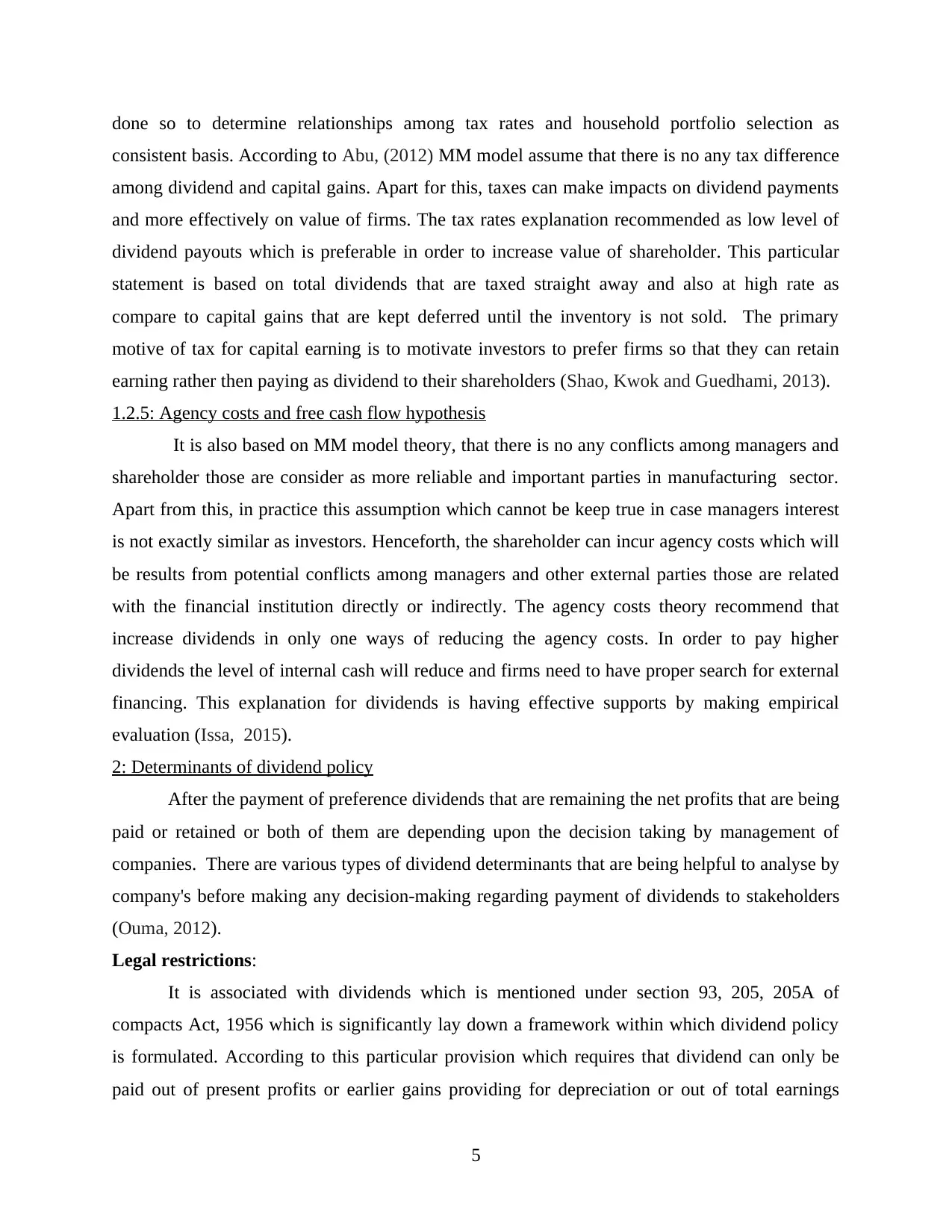
done so to determine relationships among tax rates and household portfolio selection as
consistent basis. According to Abu, (2012) MM model assume that there is no any tax difference
among dividend and capital gains. Apart for this, taxes can make impacts on dividend payments
and more effectively on value of firms. The tax rates explanation recommended as low level of
dividend payouts which is preferable in order to increase value of shareholder. This particular
statement is based on total dividends that are taxed straight away and also at high rate as
compare to capital gains that are kept deferred until the inventory is not sold. The primary
motive of tax for capital earning is to motivate investors to prefer firms so that they can retain
earning rather then paying as dividend to their shareholders (Shao, Kwok and Guedhami, 2013).
1.2.5: Agency costs and free cash flow hypothesis
It is also based on MM model theory, that there is no any conflicts among managers and
shareholder those are consider as more reliable and important parties in manufacturing sector.
Apart from this, in practice this assumption which cannot be keep true in case managers interest
is not exactly similar as investors. Henceforth, the shareholder can incur agency costs which will
be results from potential conflicts among managers and other external parties those are related
with the financial institution directly or indirectly. The agency costs theory recommend that
increase dividends in only one ways of reducing the agency costs. In order to pay higher
dividends the level of internal cash will reduce and firms need to have proper search for external
financing. This explanation for dividends is having effective supports by making empirical
evaluation (Issa, 2015).
2: Determinants of dividend policy
After the payment of preference dividends that are remaining the net profits that are being
paid or retained or both of them are depending upon the decision taking by management of
companies. There are various types of dividend determinants that are being helpful to analyse by
company's before making any decision-making regarding payment of dividends to stakeholders
(Ouma, 2012).
Legal restrictions:
It is associated with dividends which is mentioned under section 93, 205, 205A of
compacts Act, 1956 which is significantly lay down a framework within which dividend policy
is formulated. According to this particular provision which requires that dividend can only be
paid out of present profits or earlier gains providing for depreciation or out of total earnings
5
consistent basis. According to Abu, (2012) MM model assume that there is no any tax difference
among dividend and capital gains. Apart for this, taxes can make impacts on dividend payments
and more effectively on value of firms. The tax rates explanation recommended as low level of
dividend payouts which is preferable in order to increase value of shareholder. This particular
statement is based on total dividends that are taxed straight away and also at high rate as
compare to capital gains that are kept deferred until the inventory is not sold. The primary
motive of tax for capital earning is to motivate investors to prefer firms so that they can retain
earning rather then paying as dividend to their shareholders (Shao, Kwok and Guedhami, 2013).
1.2.5: Agency costs and free cash flow hypothesis
It is also based on MM model theory, that there is no any conflicts among managers and
shareholder those are consider as more reliable and important parties in manufacturing sector.
Apart from this, in practice this assumption which cannot be keep true in case managers interest
is not exactly similar as investors. Henceforth, the shareholder can incur agency costs which will
be results from potential conflicts among managers and other external parties those are related
with the financial institution directly or indirectly. The agency costs theory recommend that
increase dividends in only one ways of reducing the agency costs. In order to pay higher
dividends the level of internal cash will reduce and firms need to have proper search for external
financing. This explanation for dividends is having effective supports by making empirical
evaluation (Issa, 2015).
2: Determinants of dividend policy
After the payment of preference dividends that are remaining the net profits that are being
paid or retained or both of them are depending upon the decision taking by management of
companies. There are various types of dividend determinants that are being helpful to analyse by
company's before making any decision-making regarding payment of dividends to stakeholders
(Ouma, 2012).
Legal restrictions:
It is associated with dividends which is mentioned under section 93, 205, 205A of
compacts Act, 1956 which is significantly lay down a framework within which dividend policy
is formulated. According to this particular provision which requires that dividend can only be
paid out of present profits or earlier gains providing for depreciation or out of total earnings
5
Paraphrase This Document
Need a fresh take? Get an instant paraphrase of this document with our AI Paraphraser
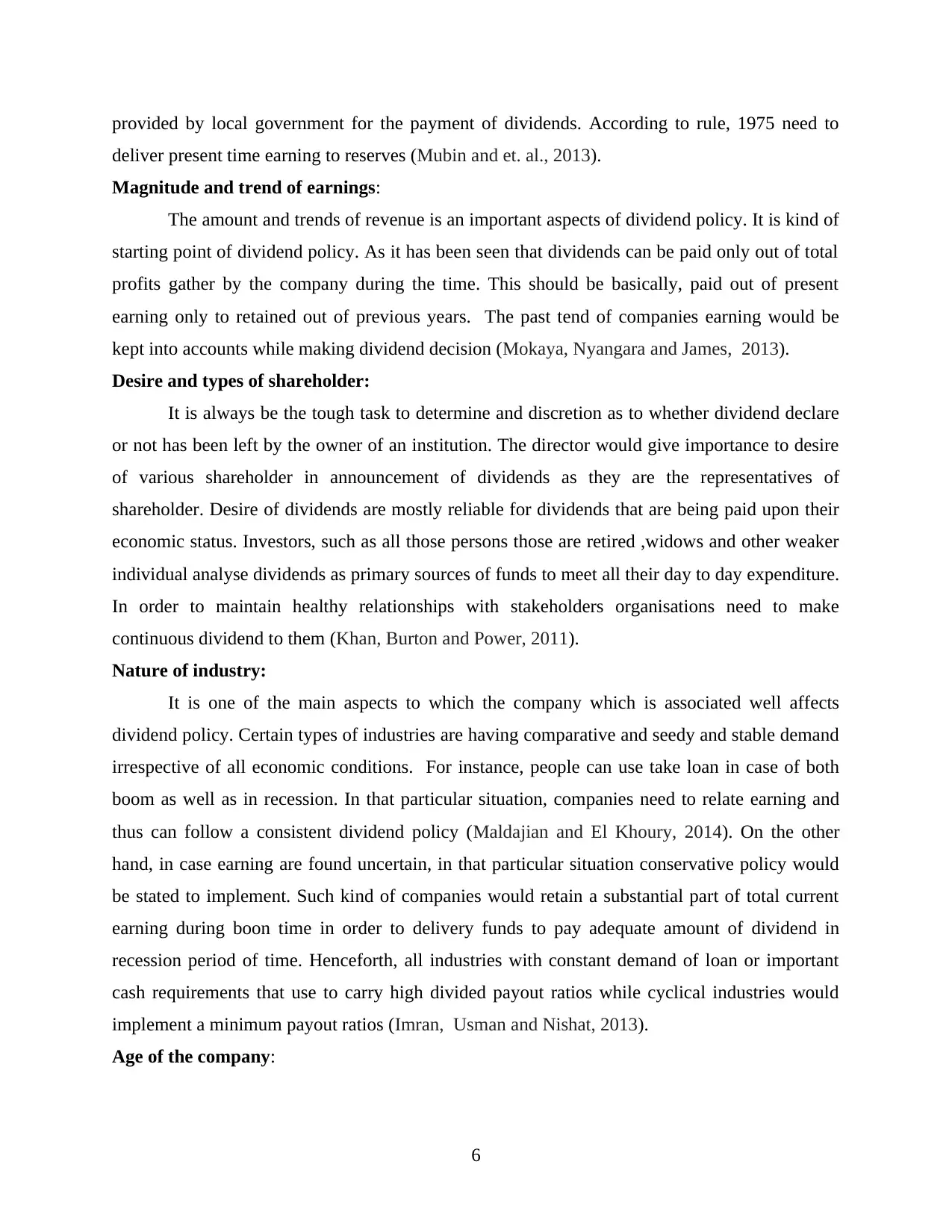
provided by local government for the payment of dividends. According to rule, 1975 need to
deliver present time earning to reserves (Mubin and et. al., 2013).
Magnitude and trend of earnings:
The amount and trends of revenue is an important aspects of dividend policy. It is kind of
starting point of dividend policy. As it has been seen that dividends can be paid only out of total
profits gather by the company during the time. This should be basically, paid out of present
earning only to retained out of previous years. The past tend of companies earning would be
kept into accounts while making dividend decision (Mokaya, Nyangara and James, 2013).
Desire and types of shareholder:
It is always be the tough task to determine and discretion as to whether dividend declare
or not has been left by the owner of an institution. The director would give importance to desire
of various shareholder in announcement of dividends as they are the representatives of
shareholder. Desire of dividends are mostly reliable for dividends that are being paid upon their
economic status. Investors, such as all those persons those are retired ,widows and other weaker
individual analyse dividends as primary sources of funds to meet all their day to day expenditure.
In order to maintain healthy relationships with stakeholders organisations need to make
continuous dividend to them (Khan, Burton and Power, 2011).
Nature of industry:
It is one of the main aspects to which the company which is associated well affects
dividend policy. Certain types of industries are having comparative and seedy and stable demand
irrespective of all economic conditions. For instance, people can use take loan in case of both
boom as well as in recession. In that particular situation, companies need to relate earning and
thus can follow a consistent dividend policy (Maldajian and El Khoury, 2014). On the other
hand, in case earning are found uncertain, in that particular situation conservative policy would
be stated to implement. Such kind of companies would retain a substantial part of total current
earning during boon time in order to delivery funds to pay adequate amount of dividend in
recession period of time. Henceforth, all industries with constant demand of loan or important
cash requirements that use to carry high divided payout ratios while cyclical industries would
implement a minimum payout ratios (Imran, Usman and Nishat, 2013).
Age of the company:
6
deliver present time earning to reserves (Mubin and et. al., 2013).
Magnitude and trend of earnings:
The amount and trends of revenue is an important aspects of dividend policy. It is kind of
starting point of dividend policy. As it has been seen that dividends can be paid only out of total
profits gather by the company during the time. This should be basically, paid out of present
earning only to retained out of previous years. The past tend of companies earning would be
kept into accounts while making dividend decision (Mokaya, Nyangara and James, 2013).
Desire and types of shareholder:
It is always be the tough task to determine and discretion as to whether dividend declare
or not has been left by the owner of an institution. The director would give importance to desire
of various shareholder in announcement of dividends as they are the representatives of
shareholder. Desire of dividends are mostly reliable for dividends that are being paid upon their
economic status. Investors, such as all those persons those are retired ,widows and other weaker
individual analyse dividends as primary sources of funds to meet all their day to day expenditure.
In order to maintain healthy relationships with stakeholders organisations need to make
continuous dividend to them (Khan, Burton and Power, 2011).
Nature of industry:
It is one of the main aspects to which the company which is associated well affects
dividend policy. Certain types of industries are having comparative and seedy and stable demand
irrespective of all economic conditions. For instance, people can use take loan in case of both
boom as well as in recession. In that particular situation, companies need to relate earning and
thus can follow a consistent dividend policy (Maldajian and El Khoury, 2014). On the other
hand, in case earning are found uncertain, in that particular situation conservative policy would
be stated to implement. Such kind of companies would retain a substantial part of total current
earning during boon time in order to delivery funds to pay adequate amount of dividend in
recession period of time. Henceforth, all industries with constant demand of loan or important
cash requirements that use to carry high divided payout ratios while cyclical industries would
implement a minimum payout ratios (Imran, Usman and Nishat, 2013).
Age of the company:
6

The age of particular company is more reliable on the dividend decisions of a company.
A newly established business concern is having to limit in payment of dividend and to retain
substantial part of revenue for financing their future growth and development. In case of old
companies which have been established sufficient reserves can afford to pay liberal dividends to
their shareholders (Determinants of Dividend Policy, 2018).
Future financial needs:
According to this particular dividend determine which cannot desires of the shareholder
but to also future financial requirements of companies are also need to be taken into
considerations in case of making dividend decisions. The management is mainly concern to
reconcile the conflicting interests of shareholder. In case UK companies are having more
profitable investment opportunities, it can convince the shareholder of for making certain
limitation to increase future earning in order to stabilise its financial positions. But when total
earning from investment opportunities does not exist then the company cannot be able to retained
substantial part of their total earnings (Jeong, 2013).
Government's economic policy:
As this specific dividend policy of a firm has also be adjusted to an economic policy of
government which was a primary case when the temporary restrictions on dividend payment was
in forced by the company. In 1975, most of the companies were allow to pay dividends not more
than 33 percent of there total profits or 12% on paid up value of share whosoever is low
(Hussainey, Oscar Mgbame and Chijoke-Mgbame, 2011).
Taxation policy:
This seems to have certain kind of policies that are impose by government that can affect
decision of any manufacturing sectors. A high or low rate of business taxation can affect the net
earning of companies after tax and thereby there dividend policy. Basically, a firms overall
dividend policy can affected by income tax statues to their shareholder. In case dividend earning
of shareholder is more heavily taxed which is being taken at high incomes slot. Most of the
shareholder sacrifice their cash dividends and prefers bonus share as well as capital gains
(Manos, Murinde and Green, 2012).
Inflation:
It is more crucial aspects that can acts as constraint during the payment of dividends. All
those profit earn from incomes statements on the basis of historical costs can have a tendency to
7
A newly established business concern is having to limit in payment of dividend and to retain
substantial part of revenue for financing their future growth and development. In case of old
companies which have been established sufficient reserves can afford to pay liberal dividends to
their shareholders (Determinants of Dividend Policy, 2018).
Future financial needs:
According to this particular dividend determine which cannot desires of the shareholder
but to also future financial requirements of companies are also need to be taken into
considerations in case of making dividend decisions. The management is mainly concern to
reconcile the conflicting interests of shareholder. In case UK companies are having more
profitable investment opportunities, it can convince the shareholder of for making certain
limitation to increase future earning in order to stabilise its financial positions. But when total
earning from investment opportunities does not exist then the company cannot be able to retained
substantial part of their total earnings (Jeong, 2013).
Government's economic policy:
As this specific dividend policy of a firm has also be adjusted to an economic policy of
government which was a primary case when the temporary restrictions on dividend payment was
in forced by the company. In 1975, most of the companies were allow to pay dividends not more
than 33 percent of there total profits or 12% on paid up value of share whosoever is low
(Hussainey, Oscar Mgbame and Chijoke-Mgbame, 2011).
Taxation policy:
This seems to have certain kind of policies that are impose by government that can affect
decision of any manufacturing sectors. A high or low rate of business taxation can affect the net
earning of companies after tax and thereby there dividend policy. Basically, a firms overall
dividend policy can affected by income tax statues to their shareholder. In case dividend earning
of shareholder is more heavily taxed which is being taken at high incomes slot. Most of the
shareholder sacrifice their cash dividends and prefers bonus share as well as capital gains
(Manos, Murinde and Green, 2012).
Inflation:
It is more crucial aspects that can acts as constraint during the payment of dividends. All
those profit earn from incomes statements on the basis of historical costs can have a tendency to
7
⊘ This is a preview!⊘
Do you want full access?
Subscribe today to unlock all pages.

Trusted by 1+ million students worldwide
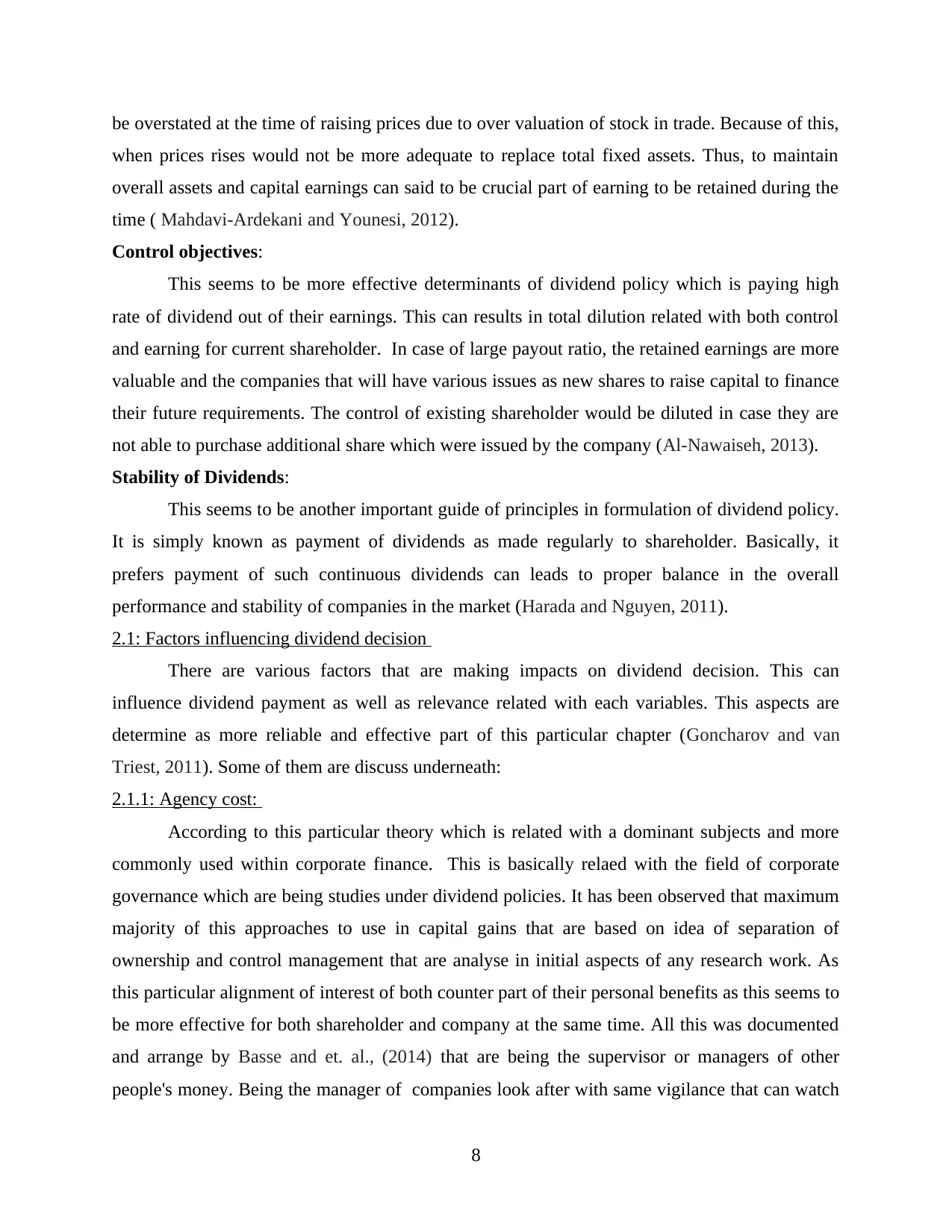
be overstated at the time of raising prices due to over valuation of stock in trade. Because of this,
when prices rises would not be more adequate to replace total fixed assets. Thus, to maintain
overall assets and capital earnings can said to be crucial part of earning to be retained during the
time ( Mahdavi-Ardekani and Younesi, 2012).
Control objectives:
This seems to be more effective determinants of dividend policy which is paying high
rate of dividend out of their earnings. This can results in total dilution related with both control
and earning for current shareholder. In case of large payout ratio, the retained earnings are more
valuable and the companies that will have various issues as new shares to raise capital to finance
their future requirements. The control of existing shareholder would be diluted in case they are
not able to purchase additional share which were issued by the company (Al-Nawaiseh, 2013).
Stability of Dividends:
This seems to be another important guide of principles in formulation of dividend policy.
It is simply known as payment of dividends as made regularly to shareholder. Basically, it
prefers payment of such continuous dividends can leads to proper balance in the overall
performance and stability of companies in the market (Harada and Nguyen, 2011).
2.1: Factors influencing dividend decision
There are various factors that are making impacts on dividend decision. This can
influence dividend payment as well as relevance related with each variables. This aspects are
determine as more reliable and effective part of this particular chapter (Goncharov and van
Triest, 2011). Some of them are discuss underneath:
2.1.1: Agency cost:
According to this particular theory which is related with a dominant subjects and more
commonly used within corporate finance. This is basically relaed with the field of corporate
governance which are being studies under dividend policies. It has been observed that maximum
majority of this approaches to use in capital gains that are based on idea of separation of
ownership and control management that are analyse in initial aspects of any research work. As
this particular alignment of interest of both counter part of their personal benefits as this seems to
be more effective for both shareholder and company at the same time. All this was documented
and arrange by Basse and et. al., (2014) that are being the supervisor or managers of other
people's money. Being the manager of companies look after with same vigilance that can watch
8
when prices rises would not be more adequate to replace total fixed assets. Thus, to maintain
overall assets and capital earnings can said to be crucial part of earning to be retained during the
time ( Mahdavi-Ardekani and Younesi, 2012).
Control objectives:
This seems to be more effective determinants of dividend policy which is paying high
rate of dividend out of their earnings. This can results in total dilution related with both control
and earning for current shareholder. In case of large payout ratio, the retained earnings are more
valuable and the companies that will have various issues as new shares to raise capital to finance
their future requirements. The control of existing shareholder would be diluted in case they are
not able to purchase additional share which were issued by the company (Al-Nawaiseh, 2013).
Stability of Dividends:
This seems to be another important guide of principles in formulation of dividend policy.
It is simply known as payment of dividends as made regularly to shareholder. Basically, it
prefers payment of such continuous dividends can leads to proper balance in the overall
performance and stability of companies in the market (Harada and Nguyen, 2011).
2.1: Factors influencing dividend decision
There are various factors that are making impacts on dividend decision. This can
influence dividend payment as well as relevance related with each variables. This aspects are
determine as more reliable and effective part of this particular chapter (Goncharov and van
Triest, 2011). Some of them are discuss underneath:
2.1.1: Agency cost:
According to this particular theory which is related with a dominant subjects and more
commonly used within corporate finance. This is basically relaed with the field of corporate
governance which are being studies under dividend policies. It has been observed that maximum
majority of this approaches to use in capital gains that are based on idea of separation of
ownership and control management that are analyse in initial aspects of any research work. As
this particular alignment of interest of both counter part of their personal benefits as this seems to
be more effective for both shareholder and company at the same time. All this was documented
and arrange by Basse and et. al., (2014) that are being the supervisor or managers of other
people's money. Being the manager of companies look after with same vigilance that can watch
8
Paraphrase This Document
Need a fresh take? Get an instant paraphrase of this document with our AI Paraphraser

over their own set of interest. By paying cash to shareholder as dividends, these resources under
the manager control that would be reduced accordingly. Thus, managers can lose their power in
more effective manner. In addition to distribution of cash to shareholder the internal funds that
are available to managers in order to reduce impacts on companies.
As Shao, Kwok and Guedhami, (2013)argued, there are two forms of agency costs. The
initial one is that cost of monitoring managers which is borne by shareholder. Whereas second
form of this cost is related with risk aversion on the part of managers. A risk averse manager
does not like to take specific amount of risk and favour to select projects which will have lower
expected return than high-risk venture. On the other hand, the shareholder would have reverse
preferences that would want managers to act as a risk preference and to take maximum chances.
Henceforth, shareholder believes that a riskier venture would provide more quick results to an
organisation.
According to Huang, Shen and Sun, (2011) another issues which might be affected by
dividend payment is conflict that are arises among shareholder and bonds holders. It has been
seen that shareholder are said to be prime agents of bondholders, hence a high level of dividend
payments to them can be taken into consideration in respect to wealth maximisation.
2.1.2: Size
The another important factors which is taken into account about decision on whether to
pay dividends or not to total size of firm. According to the studies which indicate total
percentage of 87 in large organisation to paid dividends in accordance to 49% in small size
companies. A research done by various accountants that indicate that total size of companies that
is playing important role in their dividend policy. In respect to large or central government
which can easily be access to capital market because of large companies are more mature in
comparison to small or corporative governance. The dependency to internal capital would reduce
and companies can earn maximum dividend payout during the time (Caskey and Hanlon, 2013).
2.1.3: Profitability
Aim of any companies is to pay dividend from their annual earning. However, only profit
carries by companies during the time can be easily be identified. Henceforth, considering total
level of profitability as primary factors is assist to determine dividend payout in logical manner.
It would asserted that profitability of companies to increase their demand for debts since total
companies can use internal funds to invest. They would explained as basic ideas through which
9
the manager control that would be reduced accordingly. Thus, managers can lose their power in
more effective manner. In addition to distribution of cash to shareholder the internal funds that
are available to managers in order to reduce impacts on companies.
As Shao, Kwok and Guedhami, (2013)argued, there are two forms of agency costs. The
initial one is that cost of monitoring managers which is borne by shareholder. Whereas second
form of this cost is related with risk aversion on the part of managers. A risk averse manager
does not like to take specific amount of risk and favour to select projects which will have lower
expected return than high-risk venture. On the other hand, the shareholder would have reverse
preferences that would want managers to act as a risk preference and to take maximum chances.
Henceforth, shareholder believes that a riskier venture would provide more quick results to an
organisation.
According to Huang, Shen and Sun, (2011) another issues which might be affected by
dividend payment is conflict that are arises among shareholder and bonds holders. It has been
seen that shareholder are said to be prime agents of bondholders, hence a high level of dividend
payments to them can be taken into consideration in respect to wealth maximisation.
2.1.2: Size
The another important factors which is taken into account about decision on whether to
pay dividends or not to total size of firm. According to the studies which indicate total
percentage of 87 in large organisation to paid dividends in accordance to 49% in small size
companies. A research done by various accountants that indicate that total size of companies that
is playing important role in their dividend policy. In respect to large or central government
which can easily be access to capital market because of large companies are more mature in
comparison to small or corporative governance. The dependency to internal capital would reduce
and companies can earn maximum dividend payout during the time (Caskey and Hanlon, 2013).
2.1.3: Profitability
Aim of any companies is to pay dividend from their annual earning. However, only profit
carries by companies during the time can be easily be identified. Henceforth, considering total
level of profitability as primary factors is assist to determine dividend payout in logical manner.
It would asserted that profitability of companies to increase their demand for debts since total
companies can use internal funds to invest. They would explained as basic ideas through which
9
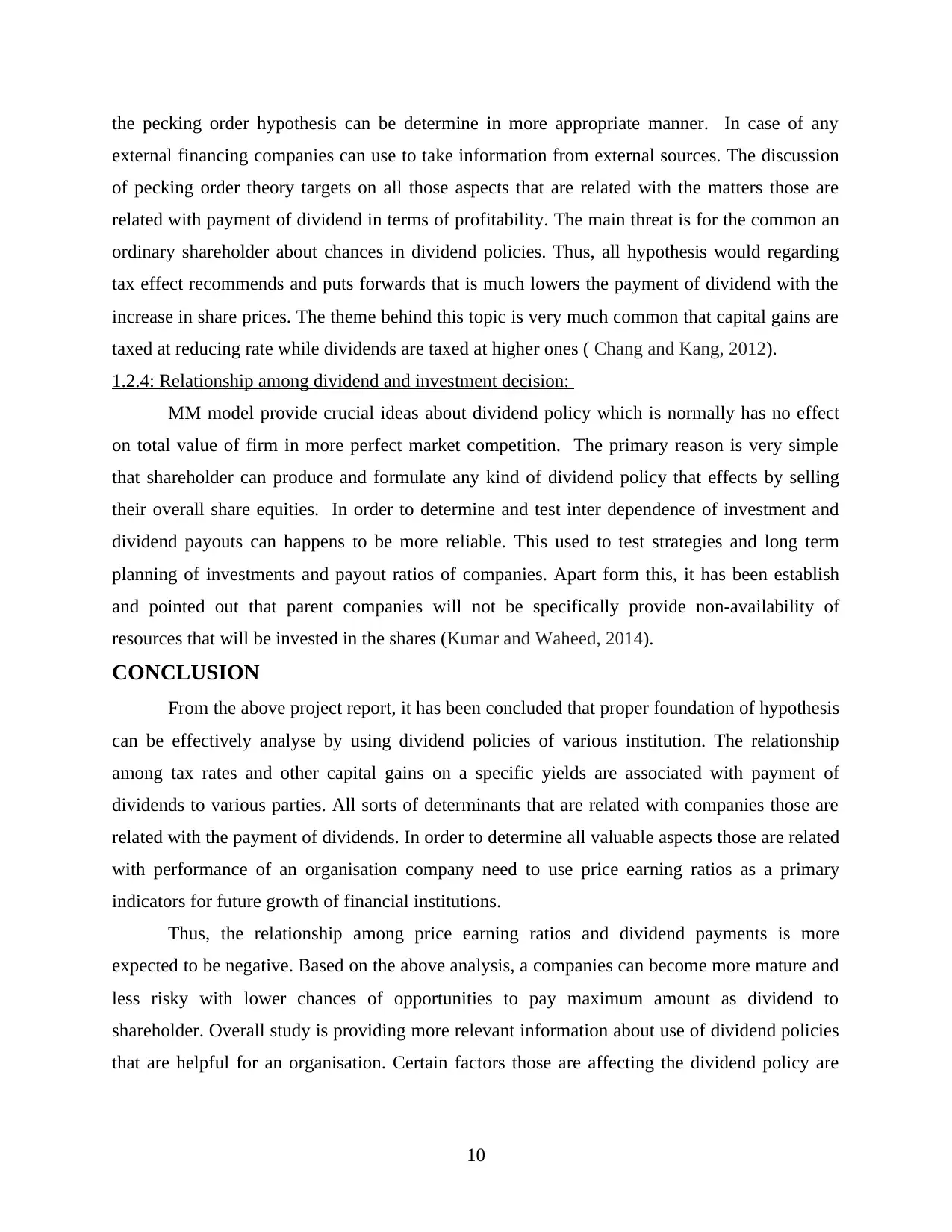
the pecking order hypothesis can be determine in more appropriate manner. In case of any
external financing companies can use to take information from external sources. The discussion
of pecking order theory targets on all those aspects that are related with the matters those are
related with payment of dividend in terms of profitability. The main threat is for the common an
ordinary shareholder about chances in dividend policies. Thus, all hypothesis would regarding
tax effect recommends and puts forwards that is much lowers the payment of dividend with the
increase in share prices. The theme behind this topic is very much common that capital gains are
taxed at reducing rate while dividends are taxed at higher ones ( Chang and Kang, 2012).
1.2.4: Relationship among dividend and investment decision:
MM model provide crucial ideas about dividend policy which is normally has no effect
on total value of firm in more perfect market competition. The primary reason is very simple
that shareholder can produce and formulate any kind of dividend policy that effects by selling
their overall share equities. In order to determine and test inter dependence of investment and
dividend payouts can happens to be more reliable. This used to test strategies and long term
planning of investments and payout ratios of companies. Apart form this, it has been establish
and pointed out that parent companies will not be specifically provide non-availability of
resources that will be invested in the shares (Kumar and Waheed, 2014).
CONCLUSION
From the above project report, it has been concluded that proper foundation of hypothesis
can be effectively analyse by using dividend policies of various institution. The relationship
among tax rates and other capital gains on a specific yields are associated with payment of
dividends to various parties. All sorts of determinants that are related with companies those are
related with the payment of dividends. In order to determine all valuable aspects those are related
with performance of an organisation company need to use price earning ratios as a primary
indicators for future growth of financial institutions.
Thus, the relationship among price earning ratios and dividend payments is more
expected to be negative. Based on the above analysis, a companies can become more mature and
less risky with lower chances of opportunities to pay maximum amount as dividend to
shareholder. Overall study is providing more relevant information about use of dividend policies
that are helpful for an organisation. Certain factors those are affecting the dividend policy are
10
external financing companies can use to take information from external sources. The discussion
of pecking order theory targets on all those aspects that are related with the matters those are
related with payment of dividend in terms of profitability. The main threat is for the common an
ordinary shareholder about chances in dividend policies. Thus, all hypothesis would regarding
tax effect recommends and puts forwards that is much lowers the payment of dividend with the
increase in share prices. The theme behind this topic is very much common that capital gains are
taxed at reducing rate while dividends are taxed at higher ones ( Chang and Kang, 2012).
1.2.4: Relationship among dividend and investment decision:
MM model provide crucial ideas about dividend policy which is normally has no effect
on total value of firm in more perfect market competition. The primary reason is very simple
that shareholder can produce and formulate any kind of dividend policy that effects by selling
their overall share equities. In order to determine and test inter dependence of investment and
dividend payouts can happens to be more reliable. This used to test strategies and long term
planning of investments and payout ratios of companies. Apart form this, it has been establish
and pointed out that parent companies will not be specifically provide non-availability of
resources that will be invested in the shares (Kumar and Waheed, 2014).
CONCLUSION
From the above project report, it has been concluded that proper foundation of hypothesis
can be effectively analyse by using dividend policies of various institution. The relationship
among tax rates and other capital gains on a specific yields are associated with payment of
dividends to various parties. All sorts of determinants that are related with companies those are
related with the payment of dividends. In order to determine all valuable aspects those are related
with performance of an organisation company need to use price earning ratios as a primary
indicators for future growth of financial institutions.
Thus, the relationship among price earning ratios and dividend payments is more
expected to be negative. Based on the above analysis, a companies can become more mature and
less risky with lower chances of opportunities to pay maximum amount as dividend to
shareholder. Overall study is providing more relevant information about use of dividend policies
that are helpful for an organisation. Certain factors those are affecting the dividend policy are
10
⊘ This is a preview!⊘
Do you want full access?
Subscribe today to unlock all pages.

Trusted by 1+ million students worldwide
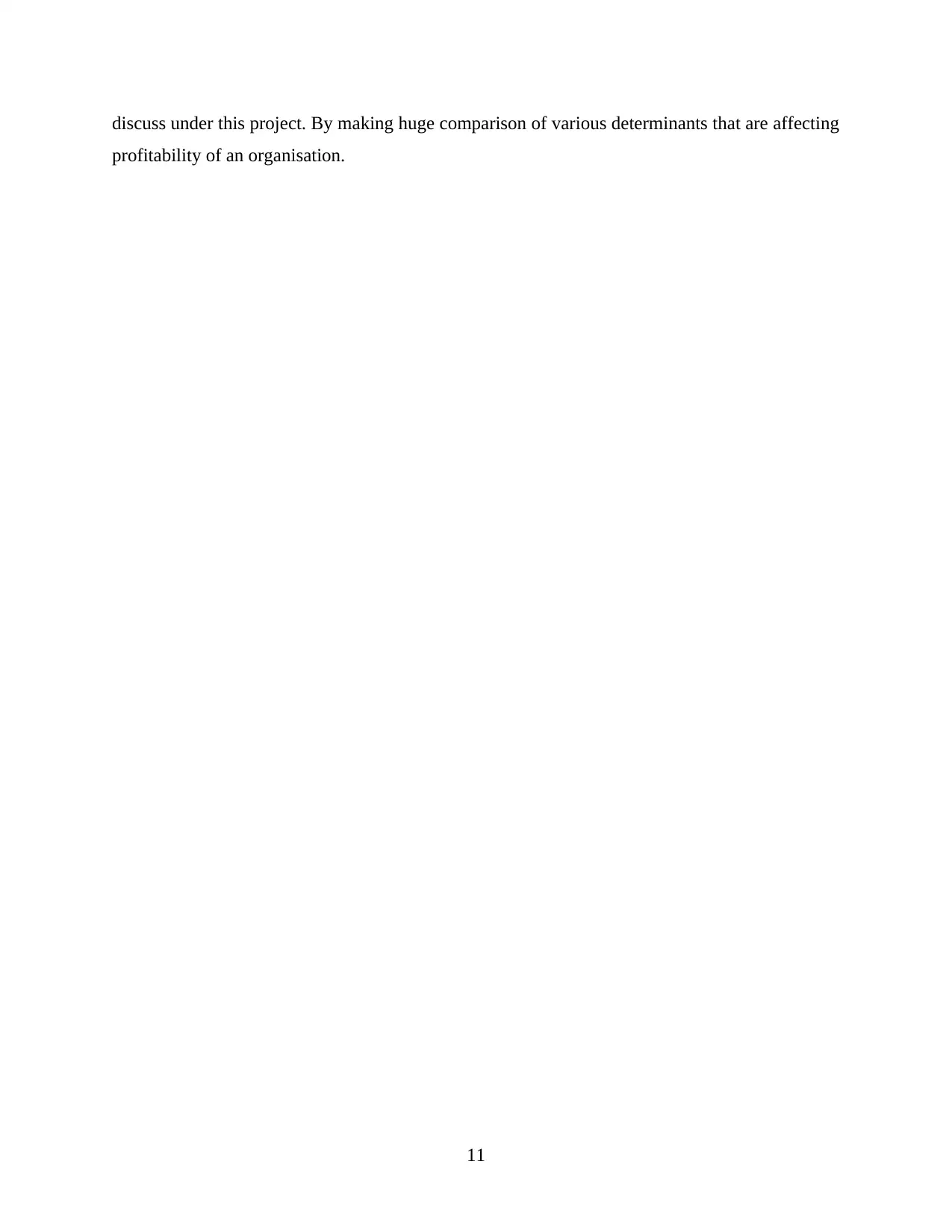
discuss under this project. By making huge comparison of various determinants that are affecting
profitability of an organisation.
11
profitability of an organisation.
11
Paraphrase This Document
Need a fresh take? Get an instant paraphrase of this document with our AI Paraphraser
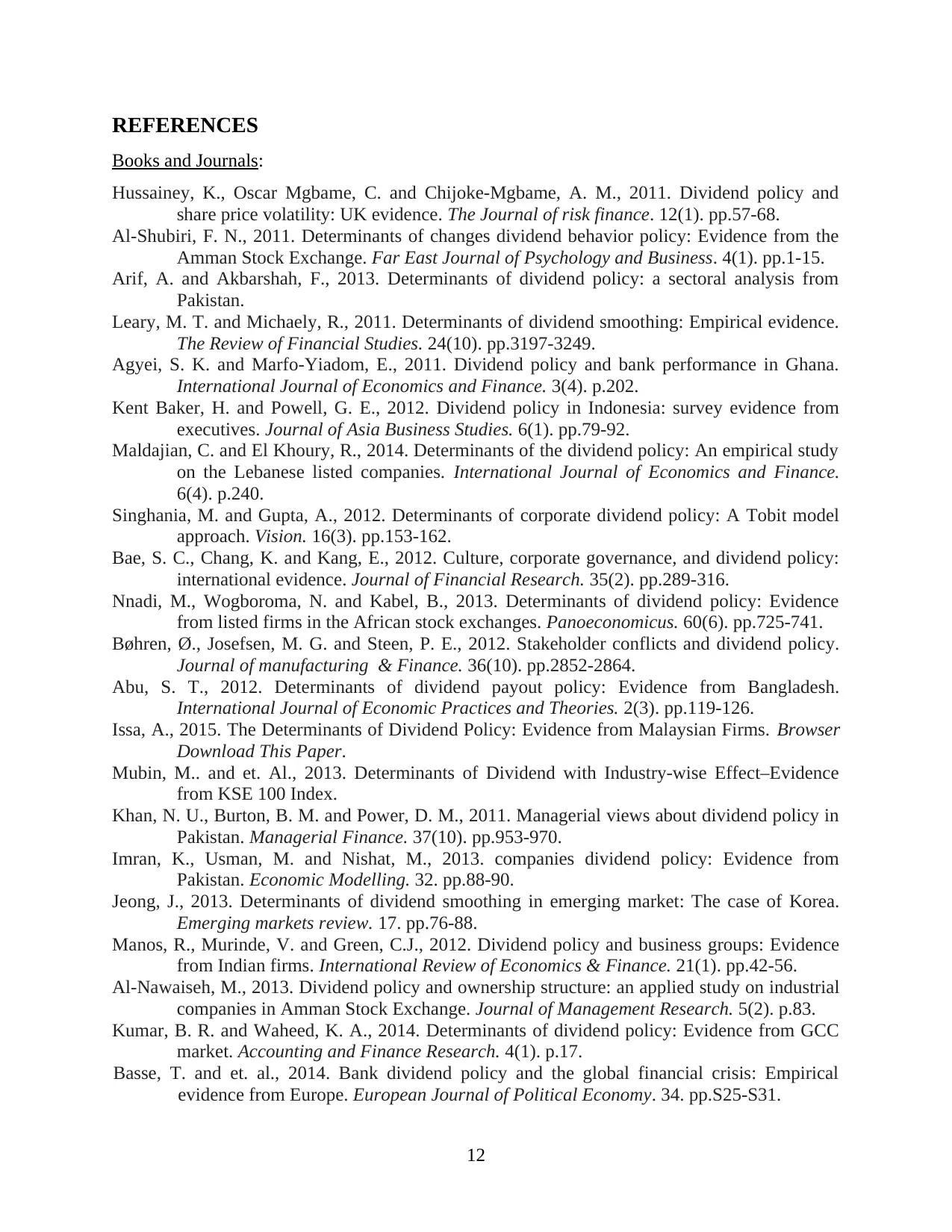
REFERENCES
Books and Journals:
Hussainey, K., Oscar Mgbame, C. and Chijoke-Mgbame, A. M., 2011. Dividend policy and
share price volatility: UK evidence. The Journal of risk finance. 12(1). pp.57-68.
Al-Shubiri, F. N., 2011. Determinants of changes dividend behavior policy: Evidence from the
Amman Stock Exchange. Far East Journal of Psychology and Business. 4(1). pp.1-15.
Arif, A. and Akbarshah, F., 2013. Determinants of dividend policy: a sectoral analysis from
Pakistan.
Leary, M. T. and Michaely, R., 2011. Determinants of dividend smoothing: Empirical evidence.
The Review of Financial Studies. 24(10). pp.3197-3249.
Agyei, S. K. and Marfo-Yiadom, E., 2011. Dividend policy and bank performance in Ghana.
International Journal of Economics and Finance. 3(4). p.202.
Kent Baker, H. and Powell, G. E., 2012. Dividend policy in Indonesia: survey evidence from
executives. Journal of Asia Business Studies. 6(1). pp.79-92.
Maldajian, C. and El Khoury, R., 2014. Determinants of the dividend policy: An empirical study
on the Lebanese listed companies. International Journal of Economics and Finance.
6(4). p.240.
Singhania, M. and Gupta, A., 2012. Determinants of corporate dividend policy: A Tobit model
approach. Vision. 16(3). pp.153-162.
Bae, S. C., Chang, K. and Kang, E., 2012. Culture, corporate governance, and dividend policy:
international evidence. Journal of Financial Research. 35(2). pp.289-316.
Nnadi, M., Wogboroma, N. and Kabel, B., 2013. Determinants of dividend policy: Evidence
from listed firms in the African stock exchanges. Panoeconomicus. 60(6). pp.725-741.
Bøhren, Ø., Josefsen, M. G. and Steen, P. E., 2012. Stakeholder conflicts and dividend policy.
Journal of manufacturing & Finance. 36(10). pp.2852-2864.
Abu, S. T., 2012. Determinants of dividend payout policy: Evidence from Bangladesh.
International Journal of Economic Practices and Theories. 2(3). pp.119-126.
Issa, A., 2015. The Determinants of Dividend Policy: Evidence from Malaysian Firms. Browser
Download This Paper.
Mubin, M.. and et. Al., 2013. Determinants of Dividend with Industry-wise Effect–Evidence
from KSE 100 Index.
Khan, N. U., Burton, B. M. and Power, D. M., 2011. Managerial views about dividend policy in
Pakistan. Managerial Finance. 37(10). pp.953-970.
Imran, K., Usman, M. and Nishat, M., 2013. companies dividend policy: Evidence from
Pakistan. Economic Modelling. 32. pp.88-90.
Jeong, J., 2013. Determinants of dividend smoothing in emerging market: The case of Korea.
Emerging markets review. 17. pp.76-88.
Manos, R., Murinde, V. and Green, C.J., 2012. Dividend policy and business groups: Evidence
from Indian firms. International Review of Economics & Finance. 21(1). pp.42-56.
Al-Nawaiseh, M., 2013. Dividend policy and ownership structure: an applied study on industrial
companies in Amman Stock Exchange. Journal of Management Research. 5(2). p.83.
Kumar, B. R. and Waheed, K. A., 2014. Determinants of dividend policy: Evidence from GCC
market. Accounting and Finance Research. 4(1). p.17.
Basse, T. and et. al., 2014. Bank dividend policy and the global financial crisis: Empirical
evidence from Europe. European Journal of Political Economy. 34. pp.S25-S31.
12
Books and Journals:
Hussainey, K., Oscar Mgbame, C. and Chijoke-Mgbame, A. M., 2011. Dividend policy and
share price volatility: UK evidence. The Journal of risk finance. 12(1). pp.57-68.
Al-Shubiri, F. N., 2011. Determinants of changes dividend behavior policy: Evidence from the
Amman Stock Exchange. Far East Journal of Psychology and Business. 4(1). pp.1-15.
Arif, A. and Akbarshah, F., 2013. Determinants of dividend policy: a sectoral analysis from
Pakistan.
Leary, M. T. and Michaely, R., 2011. Determinants of dividend smoothing: Empirical evidence.
The Review of Financial Studies. 24(10). pp.3197-3249.
Agyei, S. K. and Marfo-Yiadom, E., 2011. Dividend policy and bank performance in Ghana.
International Journal of Economics and Finance. 3(4). p.202.
Kent Baker, H. and Powell, G. E., 2012. Dividend policy in Indonesia: survey evidence from
executives. Journal of Asia Business Studies. 6(1). pp.79-92.
Maldajian, C. and El Khoury, R., 2014. Determinants of the dividend policy: An empirical study
on the Lebanese listed companies. International Journal of Economics and Finance.
6(4). p.240.
Singhania, M. and Gupta, A., 2012. Determinants of corporate dividend policy: A Tobit model
approach. Vision. 16(3). pp.153-162.
Bae, S. C., Chang, K. and Kang, E., 2012. Culture, corporate governance, and dividend policy:
international evidence. Journal of Financial Research. 35(2). pp.289-316.
Nnadi, M., Wogboroma, N. and Kabel, B., 2013. Determinants of dividend policy: Evidence
from listed firms in the African stock exchanges. Panoeconomicus. 60(6). pp.725-741.
Bøhren, Ø., Josefsen, M. G. and Steen, P. E., 2012. Stakeholder conflicts and dividend policy.
Journal of manufacturing & Finance. 36(10). pp.2852-2864.
Abu, S. T., 2012. Determinants of dividend payout policy: Evidence from Bangladesh.
International Journal of Economic Practices and Theories. 2(3). pp.119-126.
Issa, A., 2015. The Determinants of Dividend Policy: Evidence from Malaysian Firms. Browser
Download This Paper.
Mubin, M.. and et. Al., 2013. Determinants of Dividend with Industry-wise Effect–Evidence
from KSE 100 Index.
Khan, N. U., Burton, B. M. and Power, D. M., 2011. Managerial views about dividend policy in
Pakistan. Managerial Finance. 37(10). pp.953-970.
Imran, K., Usman, M. and Nishat, M., 2013. companies dividend policy: Evidence from
Pakistan. Economic Modelling. 32. pp.88-90.
Jeong, J., 2013. Determinants of dividend smoothing in emerging market: The case of Korea.
Emerging markets review. 17. pp.76-88.
Manos, R., Murinde, V. and Green, C.J., 2012. Dividend policy and business groups: Evidence
from Indian firms. International Review of Economics & Finance. 21(1). pp.42-56.
Al-Nawaiseh, M., 2013. Dividend policy and ownership structure: an applied study on industrial
companies in Amman Stock Exchange. Journal of Management Research. 5(2). p.83.
Kumar, B. R. and Waheed, K. A., 2014. Determinants of dividend policy: Evidence from GCC
market. Accounting and Finance Research. 4(1). p.17.
Basse, T. and et. al., 2014. Bank dividend policy and the global financial crisis: Empirical
evidence from Europe. European Journal of Political Economy. 34. pp.S25-S31.
12
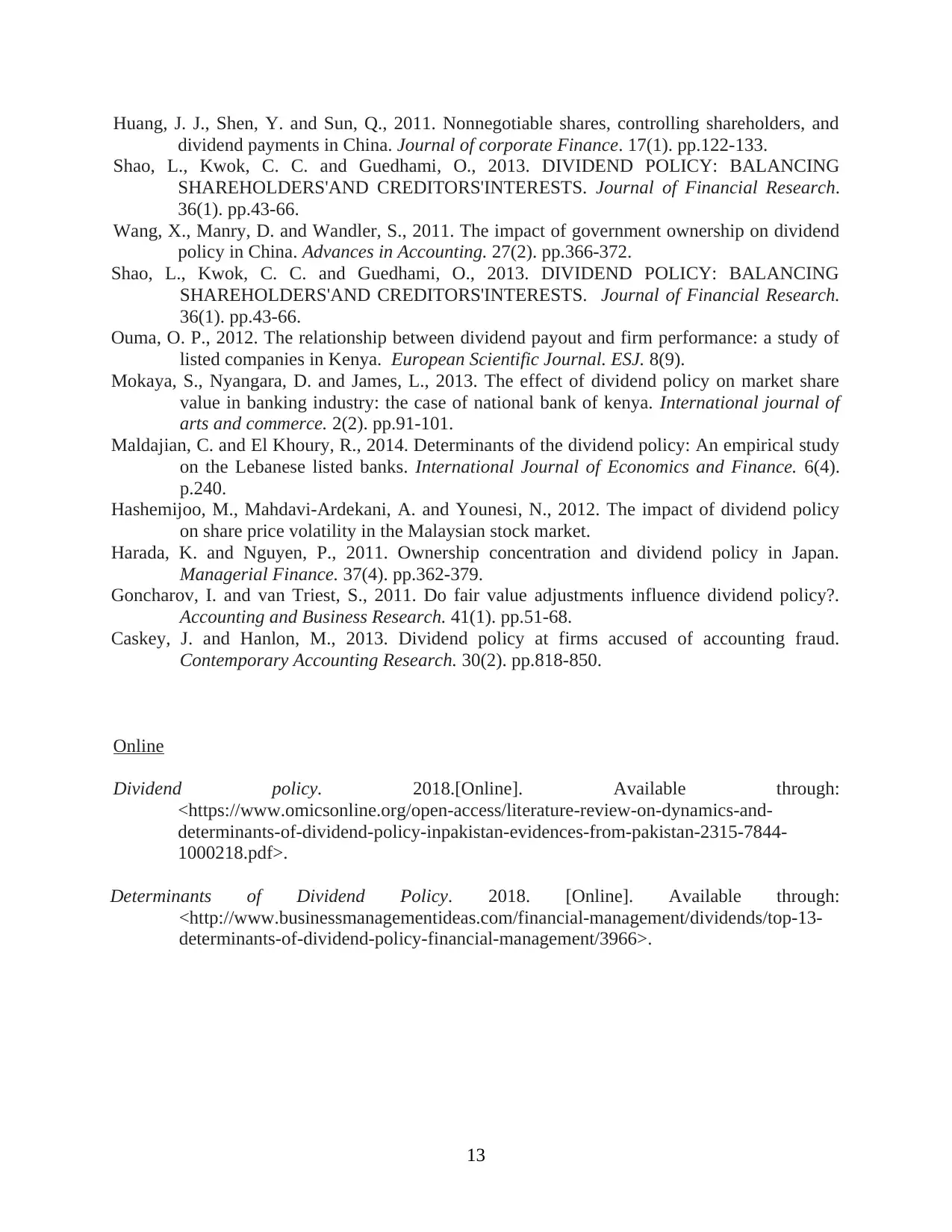
Huang, J. J., Shen, Y. and Sun, Q., 2011. Nonnegotiable shares, controlling shareholders, and
dividend payments in China. Journal of corporate Finance. 17(1). pp.122-133.
Shao, L., Kwok, C. C. and Guedhami, O., 2013. DIVIDEND POLICY: BALANCING
SHAREHOLDERS'AND CREDITORS'INTERESTS. Journal of Financial Research.
36(1). pp.43-66.
Wang, X., Manry, D. and Wandler, S., 2011. The impact of government ownership on dividend
policy in China. Advances in Accounting. 27(2). pp.366-372.
Shao, L., Kwok, C. C. and Guedhami, O., 2013. DIVIDEND POLICY: BALANCING
SHAREHOLDERS'AND CREDITORS'INTERESTS. Journal of Financial Research.
36(1). pp.43-66.
Ouma, O. P., 2012. The relationship between dividend payout and firm performance: a study of
listed companies in Kenya. European Scientific Journal. ESJ. 8(9).
Mokaya, S., Nyangara, D. and James, L., 2013. The effect of dividend policy on market share
value in banking industry: the case of national bank of kenya. International journal of
arts and commerce. 2(2). pp.91-101.
Maldajian, C. and El Khoury, R., 2014. Determinants of the dividend policy: An empirical study
on the Lebanese listed banks. International Journal of Economics and Finance. 6(4).
p.240.
Hashemijoo, M., Mahdavi-Ardekani, A. and Younesi, N., 2012. The impact of dividend policy
on share price volatility in the Malaysian stock market.
Harada, K. and Nguyen, P., 2011. Ownership concentration and dividend policy in Japan.
Managerial Finance. 37(4). pp.362-379.
Goncharov, I. and van Triest, S., 2011. Do fair value adjustments influence dividend policy?.
Accounting and Business Research. 41(1). pp.51-68.
Caskey, J. and Hanlon, M., 2013. Dividend policy at firms accused of accounting fraud.
Contemporary Accounting Research. 30(2). pp.818-850.
Online
Dividend policy. 2018.[Online]. Available through:
<https://www.omicsonline.org/open-access/literature-review-on-dynamics-and-
determinants-of-dividend-policy-inpakistan-evidences-from-pakistan-2315-7844-
1000218.pdf>.
Determinants of Dividend Policy. 2018. [Online]. Available through:
<http://www.businessmanagementideas.com/financial-management/dividends/top-13-
determinants-of-dividend-policy-financial-management/3966>.
13
dividend payments in China. Journal of corporate Finance. 17(1). pp.122-133.
Shao, L., Kwok, C. C. and Guedhami, O., 2013. DIVIDEND POLICY: BALANCING
SHAREHOLDERS'AND CREDITORS'INTERESTS. Journal of Financial Research.
36(1). pp.43-66.
Wang, X., Manry, D. and Wandler, S., 2011. The impact of government ownership on dividend
policy in China. Advances in Accounting. 27(2). pp.366-372.
Shao, L., Kwok, C. C. and Guedhami, O., 2013. DIVIDEND POLICY: BALANCING
SHAREHOLDERS'AND CREDITORS'INTERESTS. Journal of Financial Research.
36(1). pp.43-66.
Ouma, O. P., 2012. The relationship between dividend payout and firm performance: a study of
listed companies in Kenya. European Scientific Journal. ESJ. 8(9).
Mokaya, S., Nyangara, D. and James, L., 2013. The effect of dividend policy on market share
value in banking industry: the case of national bank of kenya. International journal of
arts and commerce. 2(2). pp.91-101.
Maldajian, C. and El Khoury, R., 2014. Determinants of the dividend policy: An empirical study
on the Lebanese listed banks. International Journal of Economics and Finance. 6(4).
p.240.
Hashemijoo, M., Mahdavi-Ardekani, A. and Younesi, N., 2012. The impact of dividend policy
on share price volatility in the Malaysian stock market.
Harada, K. and Nguyen, P., 2011. Ownership concentration and dividend policy in Japan.
Managerial Finance. 37(4). pp.362-379.
Goncharov, I. and van Triest, S., 2011. Do fair value adjustments influence dividend policy?.
Accounting and Business Research. 41(1). pp.51-68.
Caskey, J. and Hanlon, M., 2013. Dividend policy at firms accused of accounting fraud.
Contemporary Accounting Research. 30(2). pp.818-850.
Online
Dividend policy. 2018.[Online]. Available through:
<https://www.omicsonline.org/open-access/literature-review-on-dynamics-and-
determinants-of-dividend-policy-inpakistan-evidences-from-pakistan-2315-7844-
1000218.pdf>.
Determinants of Dividend Policy. 2018. [Online]. Available through:
<http://www.businessmanagementideas.com/financial-management/dividends/top-13-
determinants-of-dividend-policy-financial-management/3966>.
13
⊘ This is a preview!⊘
Do you want full access?
Subscribe today to unlock all pages.

Trusted by 1+ million students worldwide
1 out of 15
Related Documents
Your All-in-One AI-Powered Toolkit for Academic Success.
+13062052269
info@desklib.com
Available 24*7 on WhatsApp / Email
![[object Object]](/_next/static/media/star-bottom.7253800d.svg)
Unlock your academic potential
© 2024 | Zucol Services PVT LTD | All rights reserved.





